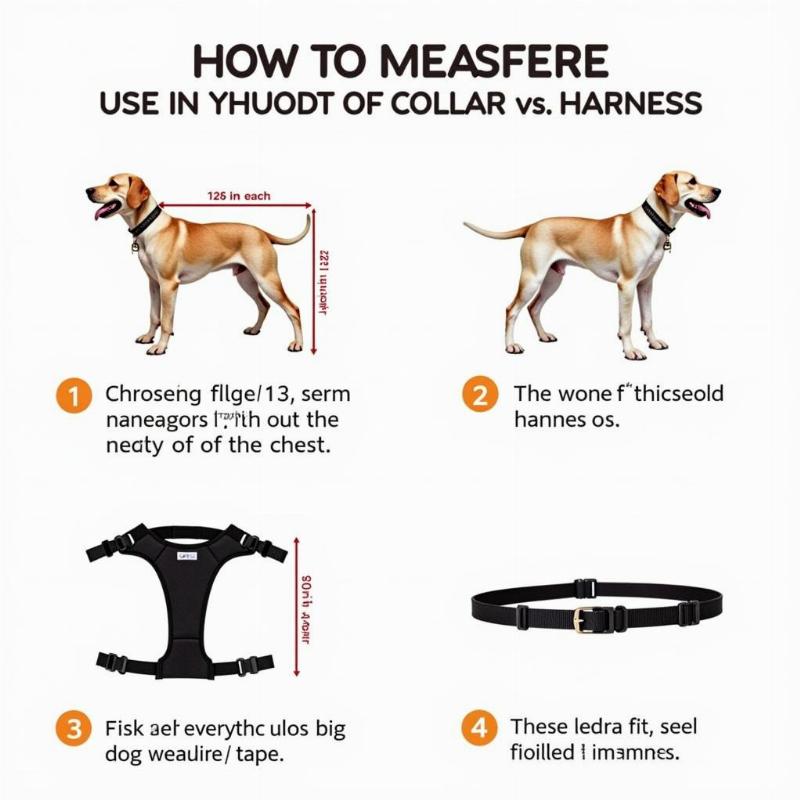A dog lead, collar, and harness set is an essential purchase for any new dog owner in the US. This combination ensures you have everything you need to safely and comfortably walk your dog, train them effectively, and provide proper identification. But with so many choices on the market, how do you select the perfect dog lead collar and harness set for your beloved companion? This guide will walk you through everything you need to consider, from size and material to training goals and breed-specific needs.
Understanding the Different Components of a Dog Lead Collar and Harness Set
Before diving into the specifics, let’s break down the purpose of each item in a dog lead collar and harness set.
Collars: Identification and Control
Collars primarily serve two purposes: displaying identification tags and providing a point of control for the leash. They come in various materials, including leather, nylon, and metal. Choosing the right collar depends on your dog’s size, coat type, and activity level.
Leads (Leashes): Guiding and Restraining
The lead, also known as a leash, connects to the collar or harness and allows you to guide and restrain your dog. Leads come in various lengths and materials, from standard nylon leashes to retractable options. Selecting the correct lead length depends on your walking environment and your dog’s training level.
Harnesses: Comfort and Safety
Harnesses offer a more comfortable and secure way to walk your dog, especially for those prone to pulling or with sensitive necks. They distribute pressure across the chest and shoulders, reducing strain on the neck and trachea. Harnesses are available in various styles, including front-clip, back-clip, and no-pull designs.
Choosing the Right Dog Lead Collar and Harness Set for Your Dog
Selecting the right gear depends on several factors, including your dog’s breed, size, age, and temperament.
Size Matters: Getting the Perfect Fit
Proper fit is crucial for both comfort and safety. A collar that’s too tight can choke your dog, while one that’s too loose can slip off. Measure your dog’s neck circumference and add a couple of inches for a comfortable fit. For harnesses, measure both the neck and chest girth.
Material Considerations: Durability and Comfort
Different materials offer different benefits. Leather is durable and stylish but requires more care. Nylon is lightweight, water-resistant, and easy to clean. Metal collars are strong but can be uncomfortable for some dogs. Consider your dog’s lifestyle and activity level when choosing the material.
Training Goals: Enhancing Control and Communication
If you’re training your dog, certain types of collars and harnesses can be more effective. For example, a martingale collar can help control pulling without choking, while a front-clip harness can discourage pulling by redirecting the dog’s forward motion.
 Dog Lead, Collar, and Harness Fitting Guide
Dog Lead, Collar, and Harness Fitting Guide
Breed-Specific Considerations: Addressing Unique Needs
Certain breeds may benefit from specific types of collars and harnesses. Brachycephalic breeds (like Bulldogs and Pugs) should generally wear harnesses instead of collars to avoid pressure on their airways. Sighthounds (like Greyhounds and Whippets) can easily slip out of standard collars, so a martingale collar or harness is recommended.
Addressing Common Concerns: Safety and Comfort
Ensure the collar or harness you choose has secure buckles and attachments. Check for any rough edges or potential irritants. Regularly inspect the gear for wear and tear, and replace it as needed.
Beyond the Basics: Accessories and Considerations
Consider adding ID tags with your dog’s name, your address, and phone number to their collar. You can also personalize your dog’s gear with decorative charms or reflective elements for added visibility at night.
Conclusion: Finding the Perfect Dog Lead Collar and Harness Set
Choosing the right dog lead collar and harness set is crucial for your dog’s safety, comfort, and training. Consider your dog’s individual needs, your training goals, and your walking environment when making your decision. With the right gear, you and your furry friend can enjoy countless happy walks together.
FAQ
- What is the best type of collar for a puppy? A lightweight, adjustable nylon collar is a good choice for a puppy.
- How often should I replace my dog’s collar and leash? Replace them as soon as they show signs of wear and tear, or at least once a year.
- Can I use a retractable leash for training? Retractable leashes can be challenging for training, as they can provide inconsistent feedback. A standard leash is usually recommended.
- What is the difference between a front-clip and back-clip harness? Front-clip harnesses discourage pulling, while back-clip harnesses are generally more comfortable for everyday walks.
- Are harnesses better than collars for all dogs? Harnesses are often a better choice for dogs that pull or have sensitive necks, but collars are fine for many dogs.
- How do I clean my dog’s collar and harness? Follow the manufacturer’s instructions. Many nylon collars and harnesses can be machine-washed.
- Where can I buy a dog lead collar and harness set? Pet stores, online retailers, and some veterinary clinics sell these sets.
Beautdogs.us is your premier online destination for all things dog-related in the US. We offer expert advice on dog breeds, care, and training, as well as a curated selection of products to enhance your dog’s life. Whether you’re a seasoned dog owner or just starting your journey, Beautdogs.us is your trusted source for comprehensive and engaging information. Contact us for all your dog-related needs at [email protected] or +1 501-555-7529.